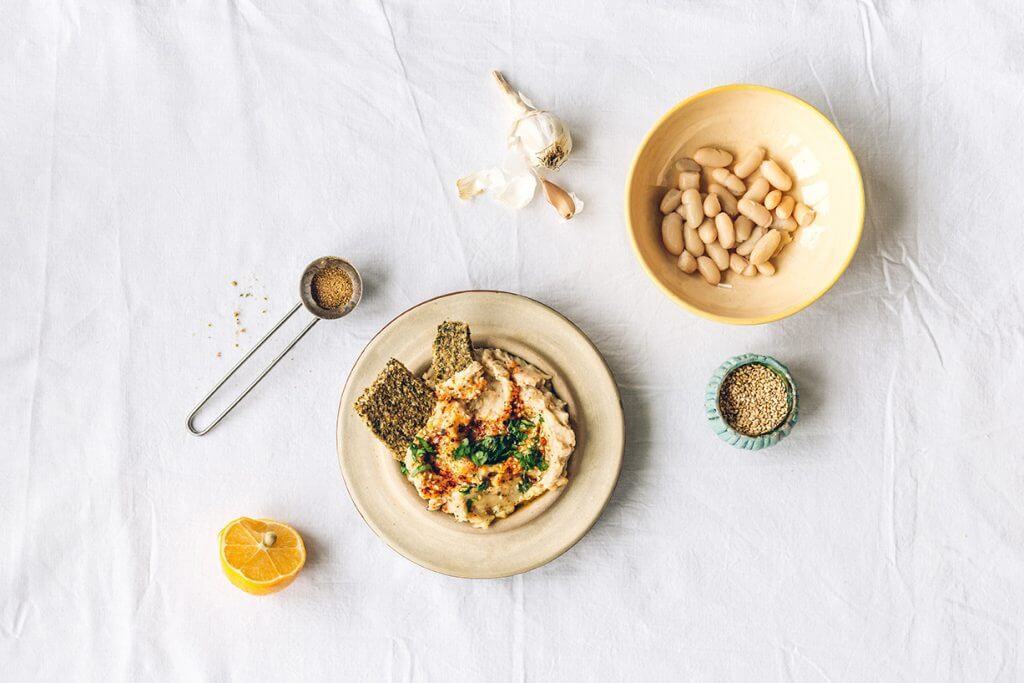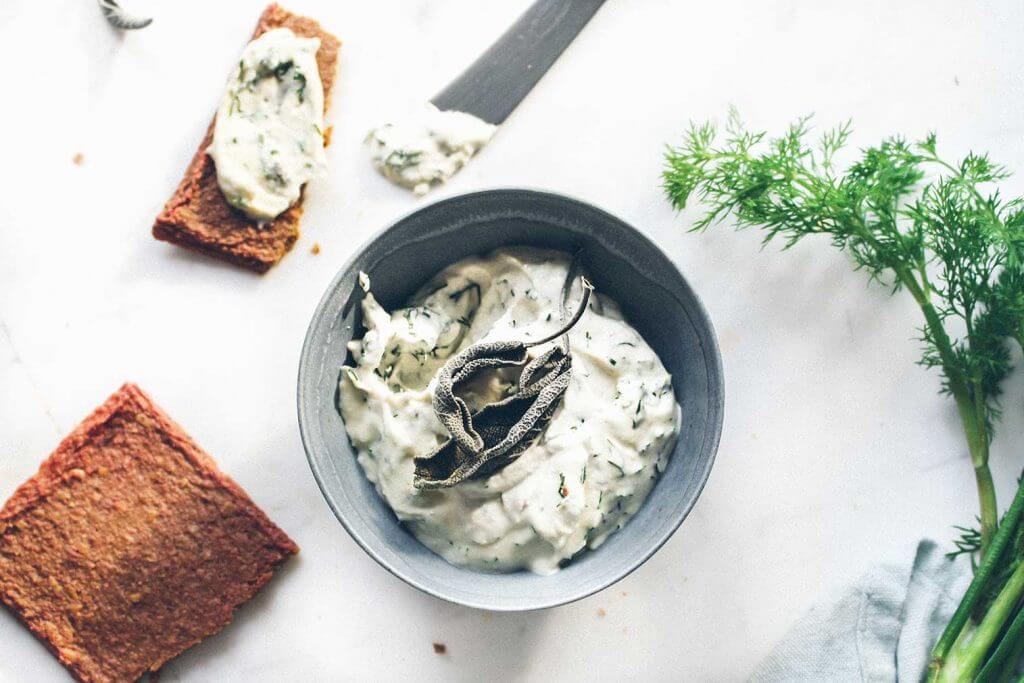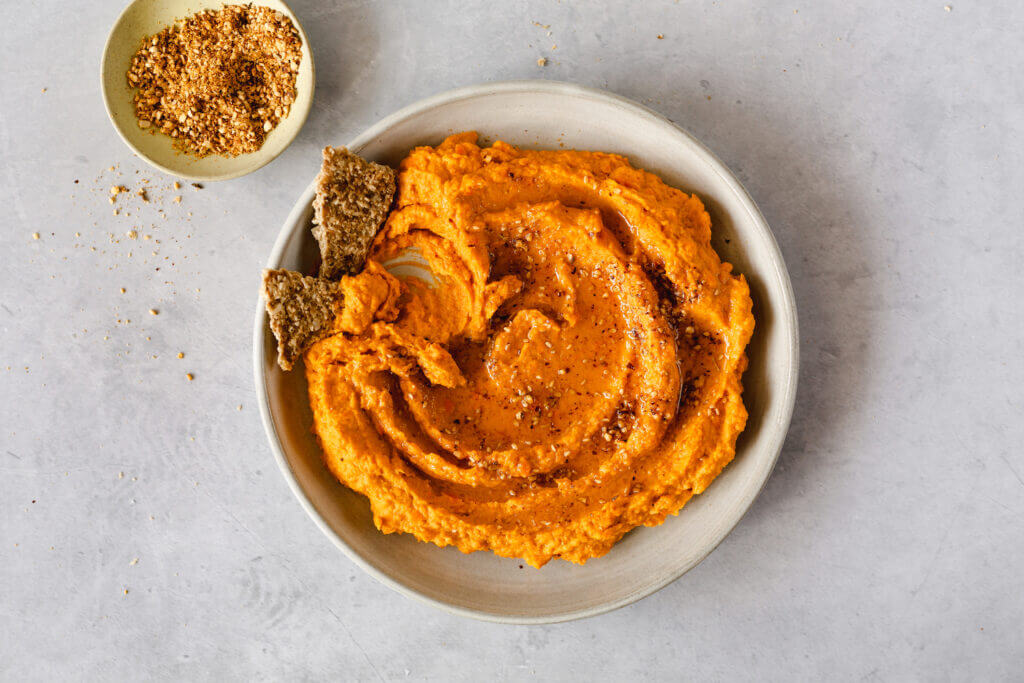Carrot dip recipe with dukkah blend
- 3

undefined 5'

undefined 8'

undefined

undefined
- 3

undefined 5'

undefined 8'

undefined

undefined
Our easy carrot dip with dukkah blend is bursting with complex flavours from the desert sunshine to the shady groves of the river Nile; the sweetness of carrots and fullness of chickpeas. In classical yogic philosophy the word duhkha means unremitting sorrow. However, in the world of epicurean delights, dukkha is a blend of exotic Egyptian spices redolent of sunshine, fertile terrain, and Middle Eastern flavours that excite the sweetness of carrots and showcase the walnutty, plumpness of chickpeas.
Carrot dip, dip dip hooray!
In our easy carrot dip with dukkah blend we use carrots and chickpeas as the star ingredients. Carrots have a sweet, aromatic and juicy texture, reminiscent of summer and autumn. Their taste profile is quiet and moderate, but they are far from bland! They are related botanically to anise, caraway, celery, root chervil, coriander, dill, fennel, parsley, and parsnips. In our carrot dip recipe we use baked carrots. Naturally sweet, baked carrots come alive with a smoky, caramel flavour. Carrots are low in calories but high in carotenoids, beta-carotene in particular, which our body converts to vitamin A. Carrots are good not only for your eyes but for your overall health!(3) Moreover, this vibrant little root vegetable so abundant in autumn and winter is vital for building good immunity. 
The health benefits of chickpeas
Slightly sweet and subdued, with earthy and starchy notes of nuts, and a creamy texture, chickpeas love to dance with flavour affinities of apricots, pistachios, and tahini. This quiet little powerhouse also revels in the spicy, loud, and hot world of Middle Eastern Cuisine. Importantly, beans are thought to be amongst the healthiest foods on the planet. For example, health professionals list chickpeas, also known as garbanzo beans, as one of the ten top health enhancing foods. Those who enjoy chickpeas and/or hummus are thought to have higher nutrient intakes of dietary fibre, polyunsaturated fatty acids, vitamins and minerals than non-garbanzo eaters. Chickpeas contain bioactive compounds, such as sterols and polyphenols.(1) Not bad for a voluptuous and firm little legume, which is shaped a little bit like a human heart. Furthermore, research suggests that chickpeas and hummus may play a beneficial role in weight management, as well as glucose and insulin regulation. They may also have a positive impact on some markers of cardiovascular disease (CVD). According to Ayurveda, the sister science of yoga philosophy, the sweet flavour of chickpeas could be beneficial to the pancreas, stomach, and heart. However, we need more research to support these claims.
Dukkah, a Middle Eastern spicy knockout
Chickpeas and dukkah seasoning have been bedfellows for centuries. Egyptians have been eating legumes on a daily basis for thousands of years, sometimes even for breakfast, and the rest of the world has been asked to do the same. Is it dukkah, dukkha or duqqa? Take your pick! Though, it’s pronounced something like Dooh-kha. Translated from Arabic, it means “to pound.” Traditionally, the herbs, nuts and spices used to make dukkah were pounded with a pestle and mortar to resemble a powder nearing a paste. Many cooks still use this method. When dukkah spice first came about, Egypt was at the interchange of the ancient spice road and had access to a vast range of spices from around the world. These spices included coriander and cumin. Combined with salt, they form the basis for the dukkah spice and are included in most dukkah recipes. However, there are many iterations to the base ingredients, with families keeping their recipes secret for generations. The eclectic seasoning of spices, herbs, nuts, and seeds is thought to originate from a throwing together of available ingredients for peasants who had little access to nourishing foods. Dipping flat bread into the spicy, crunchy fare was a great way to boost its nutritional value, not to mention the taste of bread. Today, the dukkah spice is a popular street food in the Middle East. 
Celebrating the Middle Eastern cuisine
In the West, Middle Eastern cuisine is a firm favourite, too. Many portray it as part of a Mediterranean diet of pita, hummus, kebabs, falafel and even stuffed vine leaves, which are Greek. The Middle Eastern diet, however, is a rich tapestry of flavours patched across North Africa, Arabia, Persia, the former Ottoman Empire to India! Egyptian-born British cookbook writer and anthropologist Claudia Roden has been championing the food of the Middle East since 1968 when she published her mother’s recipes in what food critics call a masterpiece: A Book of Middle Eastern Food. Roden, who has just turned 85, has inspired a legion of chefs including Middle Eastern food sensation chef Yotam Ottolenghi, the Israeli-born British chef who co-owns delis and restaurants around London. He was born in Israel in 1968, the year Roden wrote The Book of Middle Eastern Food - an alluring serendipity. While it was writer Claudia Roden who introduced dukkah certainly to the UK in the 1960s, it has been Chef Ottolenghi who has inspired a new generation to bust out their pestle and mortar and pound up the dukkah spice. Rich in flavour, it was a phenomenon just waiting to happen. Often people say, 'Oh, you introduced the UK to these ingredients," Ottolenghi is quoted as saying, which is completely wrong and I say: “No, actually Claudia Roden did.” It just took maybe another 35 years or so… for the penny to drop and for people to realise how wonderful these ingredients are.
How to use dukkah in recipes
Curious about how to use dukka in recipes? For example, Ottolenghi says he uses the nut and spice blend to bring crunch to dishes that need a little texture. Moreover, he uses it as a topper for everything from grilled vegetables to eggs and pan-fried white fish. Traditionally, the dukkah spice is served with olive oil, raw bread, or khubz, the flat bread, and raw vegetables. Plunge the bread or veggies into the silky extra virgin olive oil. Then, dunk them into the zingy spice. You can, of course, also sprinkle it over salads or add to various dips, the traditional being the labneh yogurt dish. Labneh is a soft goat cheese made by straining yogurt to remove the whey. Through the Middle East, labneh is a common addition to mezze platters. It is also a great addition dolloped on salads with a sprinkle of dukkah for extra crunch and protein! Finally, you can rub it on meats, toss into root veggie bakes, stews, pasta sauces, and sprinkle on tomatoes or avocados. For additional layers of flavour and depth, and when making dip recipes the combinations are endless! 
The basis for your dukkah recipe
Of course, you can buy readymade dukkah seasoning if you are running short of time. However, chefs note that the balance of flavours is very personal. If you want to bring additional zest to life, dukkah spice needs to have a permanent place on your kitchen shelf or kitchen cabinet. If it's too hot, try storing it in the fridge to preserve nutrients. Firstly, while recipes for dukkah spice are as varied as those who like to make it, one constant remains. The proportions of nuts to seeds and spices is pretty constant. Think mainly ⅔ nuts and seeds to ⅓ spices, or if you prefer a 50-50% split. You can use a mortar and pestle to grind the ingredients or an electric grinder.
Nuts and seeds in your dukkah recipe
The nuts are traditionally almonds or hazelnuts. However, you can toast walnuts, pecans, pistachios, peanuts, cashews, macadamia nuts, pine nuts, and sesame seeds. Or try roasting and grounding up chickpeas for an extra boost of protein and originality. How about roasted pumpkin seeds? They pack an additional punch in healthy fats and minerals. Did you know that unlike the seeds we call nuts, culinary seeds come from vegetables (such as pumpkins), flowers (such as sunflowers), or crops grown for a variety of uses (such as flax or hemp). As a result, dukkah seasoning is packed with the health benefits of nuts and seeds. They provide healthy fats, fibre and plant protein, as well as vitamins and minerals. They are great for slow-release energy as they have a low glycemic index and can help reduce blood sugars. Furthermore, nuts are good for your heart and gut health. In fact, some studies show that higher nut consumption is associated with reduced risk of heart disease. 
Dukkah seasoning for a vibrant life
The most usual dukkah seasoning mixes offer bold, earthy flavour combinations to complement an extensive list of foods. There are no limits to the ingredients you can use for flavour and texture. When pounding our own dukkah seasoning recipe, we’ve discovered the taste, in the words of Roden: “traces of those who pound their heart and soul into it.” When assembled with love, everything tastes better. In our dukkah laboratory, we have tried using hazelnuts, almonds, pistachios, cashews, pine nuts, macadamia nuts, sesame seeds, coriander, and cumin. Some optional additions are mint, thyme, dried lemon zest, caraway seeds, fennel, and nigella. Spices to experiment with are turmeric, clove, and cinnamon. Aside from the health benefits provided by nuts, dukkah contains many other healthy ingredients. The spices and herbs in dukkah provide essential vitamins and minerals. The list of ingredients used to make a traditional dukkah recipe contain rich stores of calcium, potassium, iron, zinc, magnesium and selenium, not to mention vitamin E found in nuts. Herbs such as mint, thyme, dried lemon zest and fennel, as well as the spices, are rich in antioxidants. 
The health benefits of turmeric
Turmeric is a bright yellow-orange spice. It has been used in India for thousands of years for cooking, healing, and in religious ceremonies. Turmeric is an adaptogen which means it has a modulatory effect on the body. If you are feeling stressed, it can help relax you, but if you’re feeling sluggish it can help energise you. There are a myriad impressive health benefits to turmeric, thought to be linked with a particular bioactive compound called curcumin, that you can explore. In traditional medicines, such as Ayurveda and TCM (Traditional Chinese Medicine), turmeric is used to treat a variety of health problems. Ayurveda, for instance, recommends turmeric to treat respiratory conditions as well as a runny nose, cough and sinusitis. Meanwhile, TCM makes use of turmeric in sprains and swellings and also to treat abdominal pain.
Oat and peanut crackers
Finally, we have used coconut yogurt in our dip to take into account vegan and lactose intolerant diets. The blend of carrots, chickpeas, and yogurt will be smooth and satisfying with its burst of dukkah spice blend, virgin olive oil, paprika, and cumin. Serve this carrot dip with our yummy oat and peanut crackers for additional crunch and protein. Slow-baked, they combine the comforting flavours of organic oats and peanuts in a gut-friendly snack. After folding in oats and chopped peanuts, we slow bake the dough to make a firmer, crisper cracker with plenty of satisfying crunch. We make them in small batches using the finest ingredients. We believe that snacks shouldn’t just fill you up – they should work hard for your body, too. So try them with our easy carrot dip and benefit all-over from the burst of surprising flavours all the way from desert sunshine to shady, fertile river groves. Enjoy!
- 1 cup cooked chickpeas
- 1 cup baked carrot
- Pinch of sea salt
- 4 tbsp plain coconut yogurt
- ⅛ tsp smoked paprika
- ½ tsp ground cumin
- 2 tbsp extra virgin olive oil + 1-2 tbsp for drizzling
- 1-2 tsp dukkah spice blend
- 2 packs of Erbology Organic Oat & Peanut Slow Baked Crackers
- Size: 250 g
- Serv. size: 18 g
- Place chickpeas, carrots, salt, coconut yogurt, paprika, ground cumin and oil in a food processor. Blend well until creamy. Depending on how juicy your baked carrots are, you can add a couple more tablespoons of coconut yogurt or water to get a smooth, velvety dip.
- Transfer the dip to a serving plate and top with dukkah spice blend. Drizzle 1-2 tbsp of virgin olive oil and serve with crackers. Enjoy!